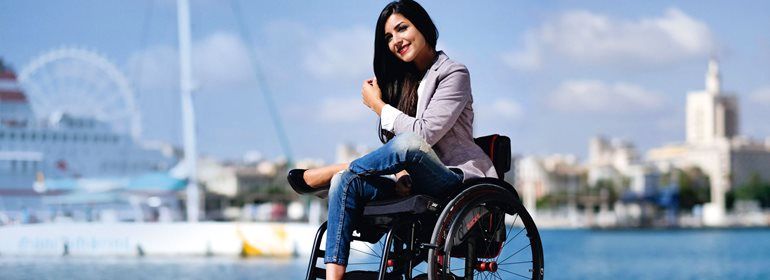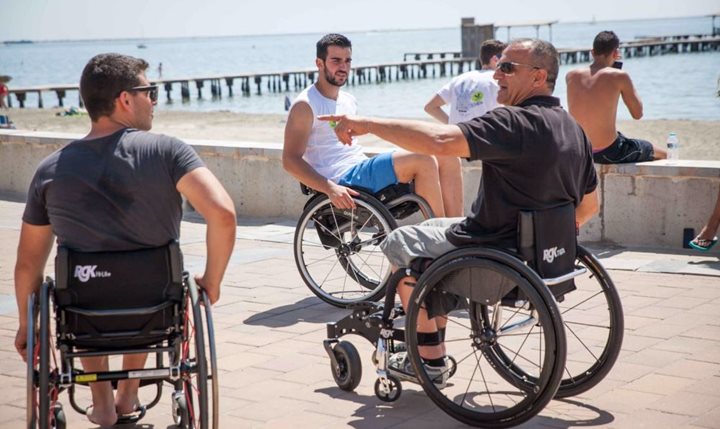Share:
Take it offline!
This Education in Motion resource is also available as a printable PDF.
Download PDF
August has arrived and you are probably planning your holiday (unless you have already done it!). Are you planning a seaside escape? If you have a physical disability, you will definitely be interested in this list of accessible beaches that we have prepared for you so that you can find all the mobility guarantees on your holiday.
When planning a trip, you should have in mind that you may need to think about some things ahead: hotels, transport, monuments to visit or reserving a table at a restaurant. If you have a disability or a mobility problem, you should be even more farsighted because, unfortunately, there are still some limitations in terms of accessibility: buildings that are partially accessible, few adapted areas in travel agencies, hotels, etc.

That is why, now that good weather has arrived and you are planning your holidays, guides like this are very useful in order to know if the beaches you are going to pass by are providing you with the necessary equipment for you to have your needs covered. Some of them are: ramps, walkways, adapted changing rooms and other aspects.

What does the term "accessible beach" imply?
In general terms, accessible beaches are those which provide people with any kind of disability (physical, visual or hearing impairment) the necessary elements so that they can enjoy a comfortable and pleasant stay, and bathe safely with the greatest freedom and independence.
In this sense, it’s not only accessible beaches that we must take into account, but also beaches with accessible points, since it is very difficult for a beach to be completely accessible. In other words, there are beaches that provide everything the people with reduced mobility would need, but they fails to adapting it for people with a higher degree of physical disability.

Which elements are neccessary for a beach to be called accessible?
For a beach to be designated as accessible, it should have some or all the following elements:
- Parking spaces reserved for people with disabilities
- Ramps should be connected to walkways, to make easier the access to the beach on a wheelchair
- Long footbridges until reaching the shore
- Adapted toilets, changing rooms, showers and foot showers
- Parasols with areas for disabled
- Amphibious chairs and crutches, to allow disabled to enjoy the sea
- Possibility to take part in adapted sports
- NOVAF machine (a type of adapted vehicle)
- Bathroom assistance staff
- Buoys and nets in the bathing area (useful for visually impaired people as it allows them to orient themselves to not to bathe beyond the bathing area limits)
Accessible beaches in Spain to get the most out of your vacation
The Discapnet website offers one of the most complete guides on accessible beaches in this country (only available in Spanish). In this guide, which is updated periodically, we can find more than 600 destinations and beaches throughout Spain where people with disabilities can rely on different services and accessibility resources to enjoy the sea.

What are the beaches offering the necessary elements for people with disabilities to enjoy their stay? We have put together this selection of the most accessible beaches according to their location:
In Andalusia
- Playa La Misericordia, in Málaga
- Playa de San Nicolás in Adra, Almería
- Playa El Palmeral in Almería
- Playa Balanegra in Berja, Almería
- Playa Las Marinicas in Carboneras, Almería
- Isla Cristina in Huelva
- Playa Las Piletas in Sanlúcar de Barrameda, Cádiz
- Playa El Rinconcillo in Algeciras, Cádiz
- Playa La Cala in Mijas, Málaga
- Playa Calahonda in Granada
In Asturias
- Playa Centro in Villaviciosa
- Playa Santa Marina in Ribadesella
- Playa Castro in Soto del Barco
In the Basque Country
- Playa La Arena in Zierbena, Vizcaya
- Playa Isuntza in Lekeitio, Vizcaya
In Murcia
- Playa Calarreona in Águilas
- Playa Los Nietos in Cartagena
- Playa La Concha in Los Alcázares
- Playa La Ermita in Mazarrón
In Galicia
- Playa Barbeira in Baiona, Pontevedra
- Playa O Muíño in A Guarda, Pontevedra
- Playa Carragueiros in Boiro, La Coruña
In the Valencian Community
- Playa Patacona in Alboraya, Valencia
- Playa San Antonio in Cullera, Valencia
- Playa de Pinedo in Valencia
- Playa Les Bovetes in Denia, Valencia
- Gran Playa in Santa Pola, Alicante
In Catalonia
- Playa Torre Valentina in Calonge, Girona
- Playa Vilafortuny in Cambrils, Tarragona
In Cantabria
- Playa Los Peligros in Cantabria
In the Canary Islands
- Playa Las Vistas in Arona, Tenerife
- Playa Amadores in Mogán, Gran Canaria
- Playa Puerto de Naos in Los llanos de Aridane, La Palma
In the Balearic Islands (beaches and bays)
- Playa Talamanca in Ibiza
- Cala Galdana in Ferreries, Menorca
- Cala Degollador in Ciutadella de Menorca
- Cala Estancia in Palma de Mallorca
- Campore Antoni in Palma de Mallorca
Moreover, if you are looking for accessible beaches you should take into account if they have made it to get the Blue Flag mark that the European Foundation of Environmental Education grants annually to beaches meeting certain requirements in terms of their environmental conditions and facilities.
For a beach to be marked with the Blue Flag, it needs to meet some requirements such as quality of water, safety and environmental management. Blue Flag beaches generally guarantee their visitors that the facilities are in good conditions, but it does not imply that they are fully accessible, as their accessibility points may not be completely adapted.
Do you want more information on how to plan a holiday taking into account accessibility barriers?We recommend you to continue reading our post Accesible tourism: how to plan your next trip.